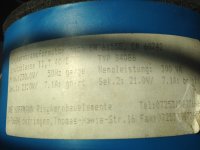….. New bulb socket . Still get a circuit with the bulb removed and the switch off …. musty be the plug socket ?
You have it connected incorrectly. Mains hot should go to the centre of the bulb. The outside connection of the bulb should go to the hot connection on the receptacle. neutrals should all connect together. If you want to add a switch' put it in the mains hot before the bulb.
…. The blue goes to N and the brown goes to the L . The brown from the plug goes into the light socket and then goes to the L on the plug socket .
Check the socket.
Is L separate from N?
Try with switch open and switch closed.
Is L and/or N broken when the switch is open?
Is L separate from N?
Try with switch open and switch closed.
Is L and/or N broken when the switch is open?
The last remaining switch is incorporated in the socket. It cannot be wired before the bulb............... If you want to add a switch' put it in the mains hot before the bulb.
The last remaining switch is incorporated in the socket. It cannot be wired before the bulb.
Is that a switch or a GFI? Our receptacles look very different in North America as are our wire colour designations.
OL on neutral switch off ,but not on the live …. remains a circuit on and off !
Can you post another picture?
Ok , so I wired a plug without a built-in switch and wired a switch in series with live ….. the tester is working ! …. I'm getting r4 on the neutral and 50r3 on the live .
Next step please ?
Next step please ?
plug is the bit you hold in your hand and has a cable to the equipment
socket is the (usually) the fixed part with tholes to receive the plug's pins.
So you wired up an unswitched socket.
Plug the tester into the mains. Leave the socket empty.
The bulb should remain OFF, Not dim, not flashing, Not ON.
Plug in a two bar electric heater. The bulb should come ON and stay ON.
Unplug the bulb, the heater should go OFF.
Plug in a transformer with nothing on the secondary side.
You might get a very brief flash or nothing.
Add on a rectifier,
You may get a very brief flash or nothing. There should be no sign of a very dimly glowing filament. A clear 40W bulb is best for this.
Add the rectifier + smoothing caps
You should get a prolonged dimming.
The clear bulb should show a very dim glow since there will be a tiny leakage in the smoothing caps. That glow should go out when the caps have fully reformed, or you used freshly reformed caps.
socket is the (usually) the fixed part with tholes to receive the plug's pins.
So you wired up an unswitched socket.
Plug the tester into the mains. Leave the socket empty.
The bulb should remain OFF, Not dim, not flashing, Not ON.
Plug in a two bar electric heater. The bulb should come ON and stay ON.
Unplug the bulb, the heater should go OFF.
Plug in a transformer with nothing on the secondary side.
You might get a very brief flash or nothing.
Add on a rectifier,
You may get a very brief flash or nothing. There should be no sign of a very dimly glowing filament. A clear 40W bulb is best for this.
Add the rectifier + smoothing caps
You should get a prolonged dimming.
The clear bulb should show a very dim glow since there will be a tiny leakage in the smoothing caps. That glow should go out when the caps have fully reformed, or you used freshly reformed caps.
All good so far … How do I wire the secondaries to the PSU board ? I have I have 2x 300va 24 transformers
thank you ,Richard
thank you ,Richard
Do ONE at a time and retest with the bulb tester.
That way you don't blow up anything else, not even the mains fuse.
That way you don't blow up anything else, not even the mains fuse.
it would appear I have a dead transformer . One reads between 19 to 24 VAC and the other reads .9 to 2.2 VAC ?
This amp has been working for 3 years until this summer …. I have a new transformer here ready to go ,but just wanted to confirm it is needed .
This was my first project and never really felt confident ,so now I'm asking as many questions as it needs to make sure I have something stable and safe .
When it died it left hest marks on the stainless steel top …. bloody scary knowing what kind of heat is needed to do that ..
This was my first project and never really felt confident ,so now I'm asking as many questions as it needs to make sure I have something stable and safe .
When it died it left hest marks on the stainless steel top …. bloody scary knowing what kind of heat is needed to do that ..
- Home
- Amplifiers
- Power Supplies
- diyAudio Power Supply Circuit Board v3 illustrated build guide
